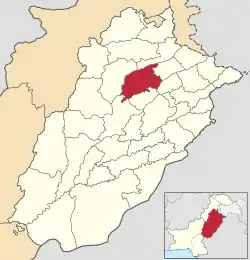Midh Ranjha
Midh Ranjha (Punjabi, Urdu 'مڈھ رانجھا' ) is a village located in Tehsil Kot Momin District Sargodha of Pakistan.[2][3][4] It is famous for Pakistan's biggest tree and is associated with the legendary Heer Ranjha story of romantic love. Heer originated in this village. Midh Ranjha is located 21 km (13 mi) from Kot Momin, 58 km (36 mi) from Sargodha city, and 247 km (153 mi) from the capital Islamabad.
Midh Ranjha
مڈھ رانجھا | |
|---|---|
| Midh Ranjha | |
 | |
| Country | Pakistan |
| Province | Punjab |
| District | Sargodha District |
| Administrative divisions | Kot Momin Tehsil |
| Population (2017 Census) | |
| • Total | 10,053[1] |
| • Estimate () | 10,000 |
| Time zone | UTC+5 (PST) |
| Calling code | 048 |
Nearby villages
Midh Ranjha is considered as a central point for several villages including Mohriwal, Abal, Dulewala, Badar Ranjha, Kot Ghazi and Thati Kalan.
Education
Schools of Midh Ranjha:
- Allied School Midh Ranjha Campus
- Arqam Grammar School
- Arqam Inter College
- Crescents School
- Govt. Higher Secondary School Boys & Girls
- Govt Primary School Boys & Girls[5]
- Knowledge City School
Biggest Banyan Tree of Pakistan
Near Midh Ranjha is the largest and oldest banyan tree in Pakistan, with over one thousand roots and covering an area of approximately three acres (1.2 ha).[6] It is situated on the banks of the Chenab river near Abhal-Mohri village, 3.6 km (2.2 mi) from Midh Ranjha. The tree is at least 400 years old, and there is a tradition that it was planted over 600 years ago by Sufi Murtaza Shah with his disciple Baba Roday Shah. The grave of Sufi Murtaza Shah is under the tree. There is a local belief that harm will come to anyone who damages the tree. Many different species of birds have their nests in its branches.[7]
Botanical classification
Botanically known as Ficus benghalensis, and belonging to the family Moraceae, the banyan tree is a native of south Asia. The fruit is like a small fig and is eaten by some people. It tastes sweeter than fig. The banyan plant is seen sometimes growing from the little wet dust deposits on buildings because birds carry them around for eating. The fruit is red and when ripe gets softer.
See also
References
- "Population and Household Details from Block to District Level. Punjab (Sargodha District). 2017 Census" (PDF). www.pbs.gov.pk. Pakistan Bureau of Statistics. Retrieved 12 February 2022.
- "Money Transfer Locations | Midh Ranjha, Punjab | Western Union". location.westernunion.com.
- "GHSS Midh Ranjha Sargodha - School Info & Teachers Profiles". UrduPoint.
- "Om Prakash Juneja: Born in 1941". www.dawn.com.
- "Govt Primary School (GPS) Midh Ranjha, Sargodha". www.urdupoint.com. Retrieved 12 February 2022.
- @GovtofPakistan (2 October 2017). "The biggest and tallest Banyan Tree of #Pakistan near midh-ranjha, district #Sargodha. Full version:…" (Tweet) – via Twitter.
- "World's second oldest tree in Pakistan". www.jasarat.com. Retrieved 12 February 2022.